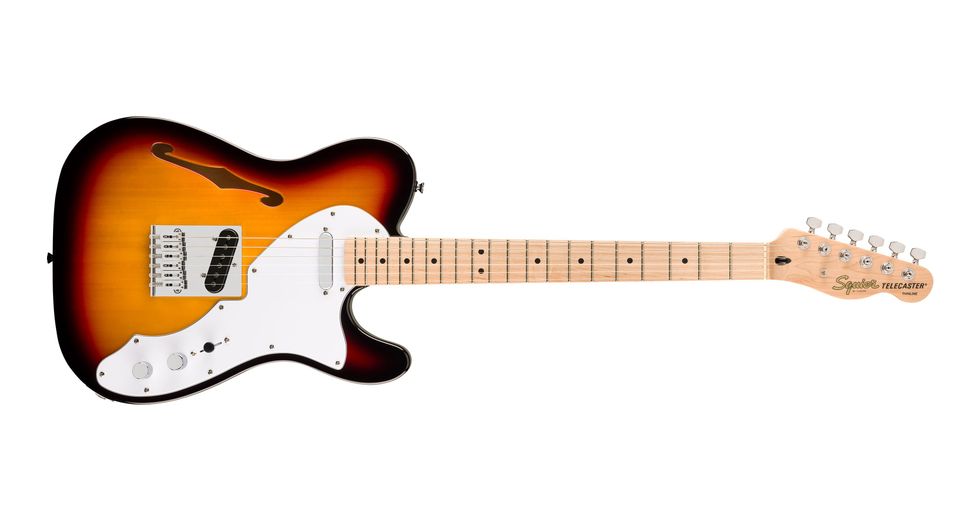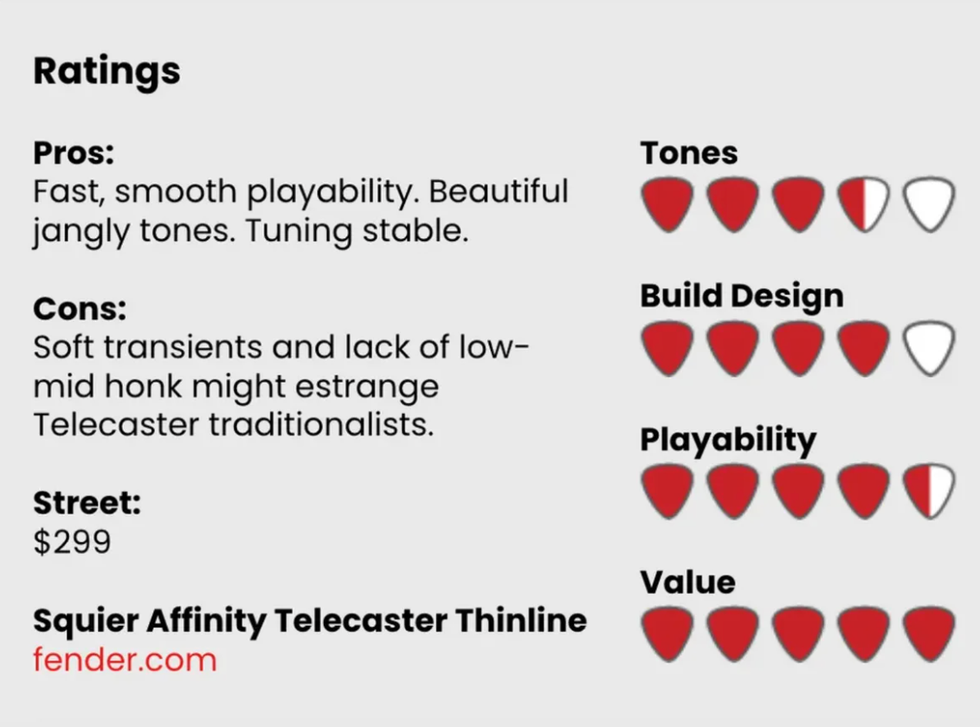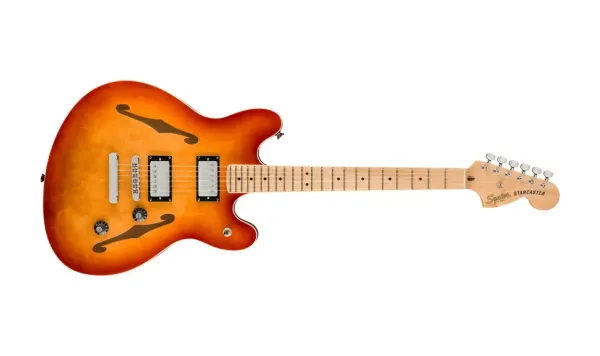The years 1969 and 1976—which bookend the releases of the original Telecaster Thinline and Starcaster—mark a strange period for Fender. They don’t signal a lost era as pre-CBS purists might insist. But there’s no doubt Fender was firing more wildly at an increasing number of moving targets—from shifting musical sands to improving import competition.
But if the very late 1960s and early/mid 1970s didn’t yield design icons on the order of the Stratocaster or Telecaster, they were a creative time for Fullerton. Few models represent that spirit—and Fender’s fluid state—quite as well as the Telecaster Thinline and Starcaster. The first was an evolution of Fender’s first solidbody executed by Roger Rossmeisl, the visionary designer behind the Rickenbacker 330 and Fender Coronado. The second was an altogether new design that, in quintessentially ’70s Fender style, managed the unlikely (some might say unholy) marriage of Jazzmaster and Gibson ES-335.
But as the ultra-affordable Squier incarnations of the Telecaster Thinline and Starcaster reviewed here prove, the folks at Fender of the late ’60s and early ’70s are entitled to a hearty last laugh: These designs are timeless and appealing enough to be around half a century later. And even in these inexpensive versions they offer genuinely interesting, stylish, and highly playable alternatives to other instruments in their price class.
Squier Affinity Starcaster Deluxe
Though collectors would have ultimately pounced on the semi-hollow Starcaster for its rarity (they were made for only four years), Radiohead’s Jonny Greenwood elevated the profile of the instrument when it was far from fashionable. More recently, blink-182’s Tom DeLonge, who now has a stripped-down signature Fender version, did much to popularize the shape. The Affinity Starcaster Deluxe is closer to DeLonge’s signature guitar, in both form and function, than Greenwood’s vintage specimen or, for that matter, Fender’s import reissue from the 2010s, or Squier’s own Classic Vibe version. Most critically, the Affinity version uses a standard humbucker with the shape and construction of a PAF rather than the Fender Wide Range, as well as a streamlined control array.
Casting Skyward
The Squier humbucker is more compressed, midrange-y, and less airy than both a Fender Wide Range pickup and the humbuckers in a contemporary Epiphone 335s—guitars which are at least $200 more than the Affinity Starcaster (not coincidentally, perhaps, in the ballpark of what a pretty nice set of PAF replacements would cost). But it’s worth spending time with the Squier humbuckers before you think about an upgrade. They are charming in their own right. By itself, the bridge pickup can be a little brash, particularly if you use a heavy touch with a pick. Lighter attack and amp tone attenuation goes a long way toward taming its more spiky tendencies, enhancing touch responsiveness, and getting glassy tones to sing a bit more. The neck pickup needs a very different treatment. I needed to bump the treble on an already bright AC15-like amp to extract the kind of tone spectrum you’d expect from a PAF, though it was quite round and chimey once I got it there. Cool sounds are here, you just may have to work for them a bit. The combined pickup setting is the sweetest sounding of the three. It also generates the sounds that communicate the most semi-hollow resonance and personality. All three settings would benefit from rangier pots. They have a pretty steep curve and limited useful range. Rolling the volume back just a few clicks, for instance, results in a fair bit of treble loss, and there’s not much variation to play with once you move through the first third of the control’s range.
Get Yer Head Straight
Curiously, Fender opted for a Stratocaster-style headstock rather than the less-ornate version of the original Starcaster headstock profile used on the standard Affinity Starcaster. While it looks sharp and balanced, it’s hard not to miss the unusual headstock shape that helped make the original Starcaster so completely different. None of this, of course, has any bearing on the Starcaster’s playability, which is really nice. The jumbo frets make active, expressive finger vibrato moves feel natural, which is nice given how the pickups and semi-hollow tones encourage you to linger on notes and use bluesy bends and phrasings.
The Verdict
One of the Indonesia-built Affinity Starcaster Deluxe’s nicest surprises is the overall quality of the construction. The neck joint is tight, the fretwork is free of sharp ends, and the finish is pretty. The pickups could be a little airier, and the smaller PAF routs probably preclude installation of Wide Range pickups, which begs a question: Would you rather pay 80 bucks more for a Squier Classic Vibe Starcaster, which offers Wide Range-sized pickups, independent volume and tone for each pickup, and a more vintage-correct headstock? I’d probably be inclined to lean that way. But considering that most affordable semi-hollows from Epiphone and Gretsch are at least $100 to $200 more, the Affinity Starcaster Deluxe is a value star with ample style that sets it apart.
Squier Affinity Telecaster Thinline


If you don’t have much bread but crave a Telecaster, the Squier website is like cruising a little paradise. As of this writing, there’s 25 ways to satisfy your jones—all for less than $500 and as inexpensive as $199. But few combinations of good looks and price stand out quite like the Affinity Telecaster Thinline. The elegance of Leo Fender and George Fullerton’s original body profile and Roger Rossmeisl’s modifications (in particular, the cresting wave pickguard) add up to a balanced whole rather than a mess whipped up by too many cooks in the kitchen.
But the Thinline is more than a style exercise. It’s a true semi-hollow with center-block construction like an ES-335 or, for that matter, the Starcaster. As a result, the Affinity Thinline is crazy light, weighing less than seven pounds. There is some downside to this lack of body heft. The guitar is prone to neck dive unless you’re wearing an especially grippy strap. But because it’s so comfortable in every other respect, you tend not to notice once you have the neck in hand.
Quest for Twang
The neck itself is maple with an additional maple fretboard cap, but the satin finish certainly takes satin to the extreme end of its definition. Though smooth and comfortable, it feels just a touch too close to unfinished for my tastes—a condition that will no doubt be remedied by many more playing hours. There are no complaints about how the guitar feels as a player, though. The action is fast and low, there’s no fret buzz, and the intonation is dead on, making this the first guitar in this price class I’ve encountered in a long time that didn’t need a significant bit of additional setup work. Even more impressively, the Thinline is tuning stable. Poor quality tuners and poorly cut nuts are often obstacles to tuning stability on inexpensive instruments. That’s not the case here, and the Thinline held up to heavy-handed, Who-’65 strumming without flinching.
The pickups deliver quintessentially Telecaster sounds, but with a twist. Whether it’s the semi-hollow construction, the ceramic pickups (Telecaster pickups are generally alnico), or a combination of factors, the Thinline has discernibly softer attack and transients than a good upmarket version, which results in a squishier low-midrange. This means a little less honk in your honky-tonk, but it makes the Thinline a lovely jangle machine—particularly in the bridge position. And if the neck pickup seems to broadcast particularly soft transients, with a bump in top end and mids from your amp, it’s a lovely vehicle for soul ballads and mellow vocal accompaniment.
The Verdict
To a dyed-in-the-wool Tele head, the Affinity Telecaster Thinline might come across as a little spongy. But it’s a fantastic guitar for rhythm work and throwing a cheap, secondhand Boss SD-1 overdrive in the mix made the Thinline snarl and rip. At $299 before tax, it’s hard to imagine a cooler inexpensive path to twangin’ and more.





























